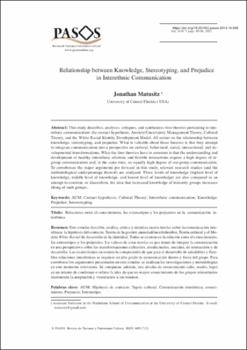Relationship between Knowledge, Stereotyping, and Prejudice in Interethnic Communication
Autor
Matusitz, JonathanFecha
2012Resumen
Este estudio describe, analiza, critica y sintetiza cuatro teorías sobre la comunicación interétnica:
la hipótesis del contacto, Teoría de la gestión ansiedad/incertidumbre, Teoría cultural y el Modelo
White Racial de desarrollo de la identidad. Todas se centran en la relación entre el conocimiento,
los estereotipos y los prejuicios. Lo valioso de estas teorías es que tratan de integrar la comunicación
en una perspectova sobre las transformaciones culturales, conductuales, sociales, de interacción y de
desarrollo. Las cuatro tienen en común la comprensión de que para el desarrollo de saludables y fl exibles
relaciones interétnicas se requiere un alto grado de comunicación dentro y fuera del grupo. Para
corroborar los argumentos presentados en este estudio, se analizan las investigaciones y metodologías
en este momento relevantes. Se comparan, además, tres niveles de conocimiento (alto, medio, bajo)
en un intento de confi rmar o refutar la idea de que un mayor conocimiento de los grupos minoritarios
incrementa la aceptación y vinculación a los mismos. This study describes, analyzes, critiques, and synthesizes four theories pertaining to interethnic
communication: the contact hypothesis, Anxiety/Uncertainty Management Theory, Cultural
Theory, and the White Racial Identity Development Model. All center on the relationship between
knowledge, stereotyping, and prejudice. What is valuable about those theories is that they attempt
to integrate communication into a perspective on cultural, behavioral, social, interactional, and developmental
transformations. What the four theories have in common is that the understanding and
development of healthy interethnic relations and fl exible interactions require a high degree of ingroup
communication and, at the same time, an equally high degree of out-group communication.
To corroborate the major arguments put forward in this study, relevant research studies (and the
methodological underpinnings thereof) are analyzed. Three levels of knowledge (highest level of
knowledge, middle level of knowledge, and lowest level of knowledge) are also compared in an
attempt to confi rm, or disconfi rm, the idea that increased knowledge of minority groups increases
liking of such groups.





